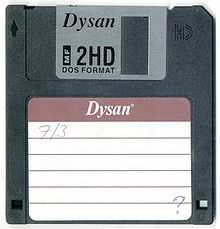Dysan

Dysan was a storage media manufacturing corporation, formed in 1973 in San Jose, California, by CEO and former president C. Norman Dion of San Jose, California. It was instrumental in the development of the 5.25" floppy disk, which appeared in 1976.
In 1983, Jerry Pournelle reported in BYTE that a software-publisher friend of his "distributes all his software on Dysan disks. It costs more to begin with, but saves [the cost of replacing defective media] in the long run, or so he says".[1] By that year Dysan was a Fortune 500 company, had over 1200 employees, and was ranked as among the top ten private sector employers within the Silicon Valley by the San Jose Mercury News, in terms of number of employees. In addition, some of Dysan's administrative and disk production facilities, located within the company's Santa Clara, California, manufacturing campus, were regarded as architecturally remarkable. For example, some of Dysan's Santa Clara campus magnetic media manufacturing facilities included architectural features such as large indoor employee lounge atriums, incorporating glass encased ceilings and walls, live indoor lush landscaping, waterfalls, running water creeks, and ponds with live fish.


In addition to manufacturing floppies, tape drives and hard disks, Dysan also produced hardware and storage containers for the disks.
Norman Dion later sold Dysan to Xidex Magnetics in the spring of 1984.
In 1997, under the direction of Jerry Ticerelli, the company declared bankruptcy.
After a brief re-opening in 2003, the company closed six months later under the direction of Dylan Campbell.
It is possible that Dysan was one of the first tech-based companies to offer a service for recycling used products. Some Dysan packaging included the following label:
Flexible media should be disposed of in an environmentally sound manner.
Consumers may send used diskettes (regardless of brand) to:
Dysan Enviro-Center
P.O. Box 361510
Milpitas, CA 95036-1510
References
- ↑ Pournelle, Jerry (June 1983). "Zenith Z-100, Epson QX-10, Software Licensing, and the Software Piracy Problem". BYTE. p. 411. Retrieved 20 October 2013.